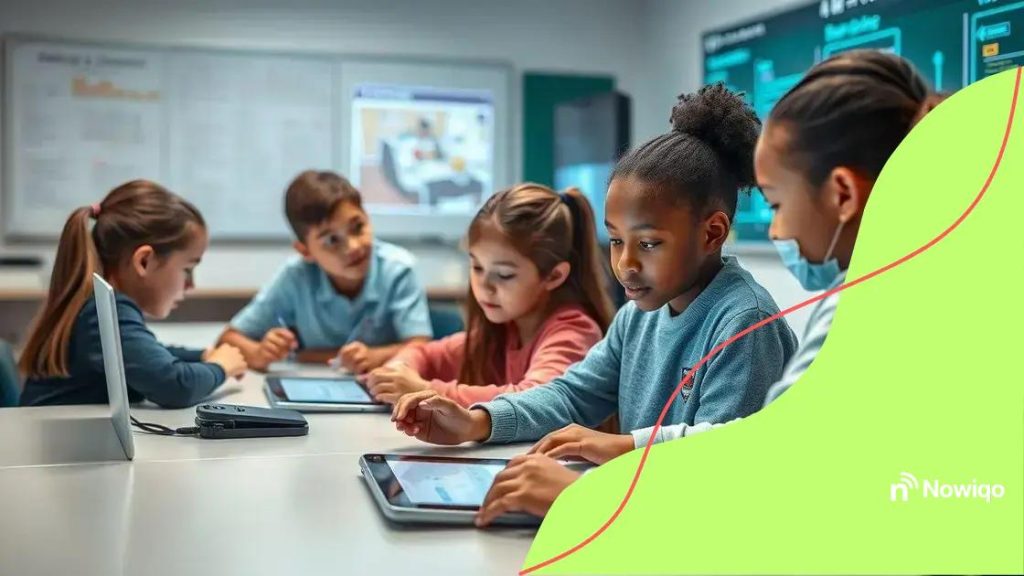AI in K-12 classrooms: transforming education today

Anúncios
AI in K-12 classrooms enhances personalized learning, supports teachers by automating tasks, and addresses individual student needs, while also presenting challenges like budget constraints and technology access.
AI in K-12 classrooms is becoming a game changer in education. Imagine a world where personalized learning experiences are the norm. Interested in how this affects your child’s education? Let’s dive in.
Anúncios
Understanding AI’s role in K-12 education
Understanding how AI integrates into K-12 education can revolutionize learning experiences for students and teachers alike. With technology evolving rapidly, it’s essential to recognize the opportunities AI brings.
The Basics of AI in Education
At its core, AI refers to systems designed to mimic human intelligence. In the classroom, this can mean adaptive learning platforms that adjust to each student’s needs. Such tools offer personalized learning paths based on individual progress.
How AI Assists Teachers
Teachers can use AI to enhance their teaching methods. For example, grading can be streamlined using AI tools, which saves time and allows teachers to focus on student interaction. Here are a few ways AI helps:
Anúncios
- Automating administrative tasks
- Providing insights on student performance
- Suggesting resources tailored to each student
Additionally, AI can help identify learning gaps early on, enabling teachers to intervene and support students before issues escalate.
Moreover, AI technology, such as interactive learning environments, encourages student engagement. When students interact with AI-driven content, they are often more motivated to learn and explore subjects deeply.
Examples of AI Tools in K-12
Some popular AI tools include:
- Intelligent tutoring systems that adapt to student learning styles.
- Chatbots that assist students with homework.
- AI-driven analytics platforms that provide performance data for teachers.
Implementing these tools not only enhances learning but also prepares students for a future that increasingly relies on digital skills.
Overall, understanding AI’s role in K-12 education opens doors for innovative teaching and learning methods, transforming the traditional classroom into a dynamic learning environment.
Benefits of AI for students and teachers
The benefits of AI for students and teachers are transforming the educational landscape. By incorporating AI technologies, both groups can enhance their learning and teaching experiences.
Personalized Learning Experiences
One major advantage of AI is the ability to create personalized learning paths. Students can work at their own pace, receiving tailored content that matches their individual strengths and weaknesses. This personalization helps in boosting confidence and improving overall performance.
Support for Teachers
Teachers also benefit greatly from AI tools. By automating grading and administrative tasks, they can dedicate more time to interacting with students. Here are some key support features:
- Data analysis to understand student progress
- Recommendations for lessons based on performance
- Immediate feedback tools that help students improve
Furthermore, AI can assist teachers in identifying students who may need extra help. This proactive approach allows for timely interventions, making the learning environment more inclusive.
Engagement and Motivation
Another benefit of AI in the classroom is that it increases student engagement. Interactive AI applications can turn learning into a fun and exciting experience. When students enjoy what they are learning, they are more likely to participate actively.
In addition, AI can provide instant access to resources. Students can explore topics of interest beyond the standard curriculum, broadening their knowledge and encouraging a love for learning.
Effective tools for integrating AI

Integrating AI into the classroom requires effective tools that enhance learning and teaching. Various technologies can help streamline this process, making it easier for both students and educators to benefit from AI.
AI-Powered Learning Platforms
Learning platforms such as adaptive learning software are essential. These platforms assess student performance and tailor educational content to meet individual needs. Students receive personalized lessons that match their learning styles.
AI Tools for Assessment
Assessment tools utilizing AI can drastically change how grading is approached. Instead of manual grading, educators can use automated systems to evaluate student work quickly. These tools can:
- Provide instant feedback on assessments
- Analyze trends in student performance over time
- Suggest areas for improvement based on data
By adopting these systems, teachers can allocate their time more effectively, focusing on teaching rather than paperwork.
Chatbots for Student Support
Another innovative tool is the use of AI chatbots. These chatbots can interact with students, answering questions and providing information outside of regular class hours. This feature enhances learning by allowing students to seek help at their convenience. Benefits include:
- 24/7 access to information
- Immediate responses to common queries
- Increased engagement in learning
These tools foster an interactive learning environment, making education more accessible and engaging for everyone.
In summary, integrating AI tools such as adaptive learning platforms, assessment software, and chatbots can significantly improve the educational experience. They not only support teachers but also empower students to take charge of their learning journey.
Challenges in implementing AI in schools
Implementing AI in schools presents various challenges that educators and administrators must navigate. Understanding these obstacles is crucial for successful integration.
Technological Barriers
Many schools face issues with outdated technology. Access to reliable computers and internet connections is vital for AI tools to function effectively. Without the right infrastructure, even the best AI software can fail to deliver results. Many districts, especially in low-income areas, may struggle to provide the necessary resources.
Cost and Funding
Another significant challenge involves the cost of AI implementation. Schools often have tight budgets, and purchasing new technology, software licenses, and training can be expensive. Here are some financial concerns:
- Upfront costs for software and hardware
- Ongoing maintenance and updates
- Training for teachers and staff
Without adequate funding, adopting AI can become a burden rather than a benefit.
Resistance to Change
In many cases, resistance to change can hinder AI adoption among teachers and staff. Some educators may feel overwhelmed by new technologies, fearing it may replace traditional teaching methods. Others might lack confidence in using AI tools effectively.
Overcoming this resistance requires effective training, support, and communication about the benefits of AI. When educators understand how AI can enhance their teaching, they are more likely to embrace it.
Ethical and Privacy Concerns
Finally, ethical implications of AI in education must be considered. Issues related to data privacy, consent, and bias in AI algorithms can raise significant concerns. Parents and educators may worry about how student data is collected and used.
Addressing these challenges is vital to ensure that AI projects align with educational goals and maintain trust within the school community.
Future trends of AI in education
The future trends of AI in education are promising and can radically change how students learn and teachers educate. As technology evolves, schools are beginning to adopt innovative approaches that cater to diverse learning styles.
Increased Personalization
One major trend is the push for even greater personalization in education. AI algorithms will analyze student data more effectively, providing tailored learning experiences that adapt in real-time. For instance, platforms could adjust the speed and style of content delivery based on student understanding and progress, making learning more engaging.
Enhanced Teacher Support
AI is set to provide robust support for teachers by handling administrative tasks. This shift will free teachers to focus more on creating dynamic lessons. Here are some examples of how AI can enhance teaching support:
- Automating grading processes to save time.
- Offering sophisticated data analytics to inform instruction.
- Sharing resources and strategies across classrooms.
This support allows educators to spend more time working directly with students, fostering stronger relationships and better educational outcomes.
Virtual and Augmented Reality
Another exciting trend is the incorporation of virtual and augmented reality. These technologies can create immersive learning environments, allowing students to explore complex concepts in interactive ways. For example, history students could take virtual field trips to ancient cities, while science classes could conduct virtual experiments.
Integrating AI with these technologies will enable even more personalized experiences, allowing students to learn in ways that are natural and engaging for them.
Data-Driven Decision Making
The use of AI will increase the reliance on data-driven decision-making in educational settings. Schools will harness large datasets to inform not only individual student strategies but also curriculum development. With ongoing insights, educators can determine which teaching methods are most effective and tailor approaches accordingly.
As these trends develop, it remains essential for schools to embrace change thoughtfully and ethically, ensuring that AI serves every student’s best interests.
FAQ – Frequently Asked Questions about AI in Education
How does AI personalize learning for students?
AI analyzes student data and adapts learning materials to fit individual needs, ensuring that each student receives a tailored educational experience.
What are the main benefits of AI for teachers?
AI helps teachers save time on administrative tasks, provides insights into student performance, and supports personalized instruction, allowing teachers to focus on engaging with their students.
What challenges do schools face when implementing AI?
Schools often encounter issues such as budget constraints, outdated technology, and resistance to change from staff, which can hinder successful implementation.
What future trends can we expect with AI in education?
Future trends include increased personalization of learning, enhanced teacher support through AI tools, and the integration of virtual reality for immersive learning experiences.